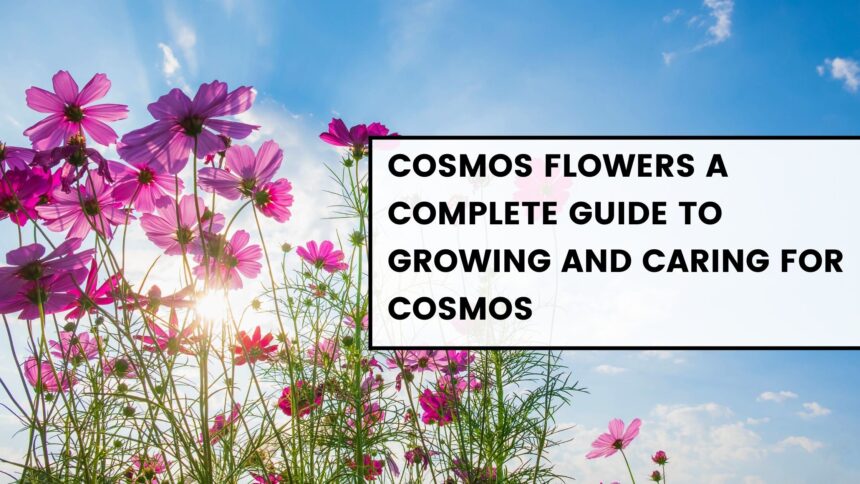Cosmos Flowers are a gardener’s delight, bringing vibrant color and elegance to any garden. Their delicate, daisy-like appearance belies their robust and low-maintenance nature. Whether you’re a seasoned gardener or just starting out, cosmos flowers are an excellent choice to brighten up your outdoor space.
In this comprehensive guide, we’ll delve into everything you need to know about cosmos flowers — from planting and caring for them to common questions and troubleshooting tips.
What Are Cosmos Flowers?
Cosmos flowers belong to the Asteraceae family and are native to Mexico and Central America. These annual flowers come in a variety of colors, including pink, white, yellow, orange, and red. Cosmos plants typically grow between 1 to 6 feet tall, depending on the variety, and their feathery foliage adds a delicate texture to garden landscapes.
Why Should You Grow Cosmos Flowers?
Cosmos flowers are popular for several reasons:
- Easy to Grow: Cosmos thrive in various soil types and tolerate poor soils better than many other flowers.
- Drought-Resistant: Once established, cosmos can tolerate dry conditions, making them ideal for gardens in arid regions.
- Pollinator Friendly: These flowers attract bees, butterflies, and other pollinators, making them an excellent choice for eco-friendly gardening.
- Long Blooming Season: Cosmos bloom continuously from summer until the first frost, providing extended beauty in the garden.
How to Plant Cosmos Flowers
1. Choosing the Right Variety
There are two main species of cosmos to choose from:
- Cosmos bipinnatus: Known for its large, colorful blooms in shades of pink, white, and purple.
- Cosmos sulphureus: Characterized by its bright orange and yellow flowers, this variety is more heat-tolerant.
2. Best Time to Plant
Cosmos seeds should be planted after the last frost. They prefer warm temperatures and full sun, so wait until your soil has warmed to at least 60°F (16°C).
3. Where to Plant Cosmos
Cosmos thrive in areas that receive full sunlight (at least 6 hours of direct sunlight per day). They can be planted directly into garden beds or grown in containers. Because of their height, they’re excellent for borders, flower beds, and adding vertical interest to your garden.
4. Soil Requirements
Cosmos prefer well-drained soil, but they aren’t fussy. In fact, cosmos thrive in poor, rocky soil where other plants might struggle. Avoid overly rich soil, as this can lead to excessive foliage growth at the expense of flowers.
5. How to Plant Cosmos Seeds
Plant cosmos seeds directly into the garden. Follow these steps:
- Sow seeds 1/4 inch deep and 12–18 inches apart.
- Water the soil lightly after planting.
- Cosmos seeds germinate in 7–21 days.
| Planting Summary | Details |
|---|---|
| Seed Depth | 1/4 inch |
| Spacing Between Plants | 12–18 inches |
| Germination Time | 7–21 days |
| Sunlight Requirements | Full sun (6+ hours of sunlight) |
Cosmos Flower Care
1. Watering
While cosmos are drought-tolerant, they need regular watering when young. Once established, water them moderately. Be careful not to overwater, as cosmos prefer slightly dry conditions.
2. Fertilizing
Cosmos do not need much fertilizer. Too much nitrogen will result in lush foliage but fewer flowers. A light application of balanced fertilizer (10-10-10) once a season is more than enough.
3. Deadheading and Pruning
Remove spent flowers (deadheading) to encourage continuous blooming. Cosmos are self-seeding, so if you leave some flowers on the plant, they will drop seeds and grow back the following year.
4. Pests and Diseases
Cosmos are generally pest-free, but they can sometimes fall prey to aphids or spider mites. If you notice pests, spray the plants with a mild soapy water solution. Cosmos are also resistant to most diseases but may suffer from powdery mildew in overly humid conditions.
Common Problems with Cosmos Flowers
1. No Blooms
If your cosmos aren’t blooming, it could be due to overly fertile soil. Cosmos flowers thrive in poor soil, so if you’ve over-fertilized, you might see lots of green growth with no flowers.
2. Leggy Growth
Cosmos can become tall and leggy, especially in shady areas. Ensure they are planted in full sun and pinch the tips of young plants to encourage bushier growth.
Best Companion Plants for Cosmos Flowers
Companion planting is a gardening technique where plants are grown together to enhance growth, deter pests, or improve the soil. Cosmos flowers, with their tall stems and long blooming period, make excellent companions for many plants. Here’s a list of the best companion plants for cosmos, along with the benefits they offer to your garden.
1. Zinnias
Zinnias and cosmos make a colorful and striking combination in any garden. Both are drought-tolerant and require similar growing conditions, thriving in full sun and well-drained soil. The bright colors of zinnias complement cosmos, and together, they create a pollinator-friendly environment that attracts bees and butterflies.
Benefits:
- Both flowers thrive in similar conditions.
- Attract beneficial pollinators.
2. Marigolds
Marigolds are known for their ability to deter pests such as nematodes and aphids, making them a great companion for cosmos. These vibrant flowers also add a splash of bright color to your garden and blend well with cosmos.
Benefits:
- Pest control properties (repel nematodes and aphids).
- Complementary colors.
3. Sunflowers
Sunflowers provide excellent structure and height variation when planted with cosmos. Their tall stalks create a natural backdrop, while cosmos adds softness and texture in front. Both plants thrive in full sun, and sunflowers can help provide a bit of shade for shorter cosmos flowers during the hottest part of the day.
Benefits:
- Height contrast adds visual interest.
- Both are heat and drought-tolerant.
4. Coreopsis
Coreopsis and cosmos flowers are a match made in heaven for gardeners who love wildflower gardens. Both bloom for long periods and attract pollinators such as bees and butterflies. These flowers can create a wild, natural-looking garden that requires little maintenance.
Benefits:
- Attracts pollinators.
- Long-lasting blooms and easy maintenance.
5. Salvia
Salvia, especially the blue or purple varieties, makes a striking contrast when paired with cosmos flowers. Like cosmos, salvia is drought-tolerant and prefers well-drained soil. It attracts beneficial insects like bees, which help pollinate other plants in your garden.
Benefits:
- Attracts pollinators, especially bees.
- Beautiful color contrast.
6. Lavender
Lavender is another excellent companion for cosmos, particularly in areas with hot, dry summers. Both plants thrive in full sun and well-drained soil, and lavender’s aromatic foliage helps repel pests like moths and aphids. The purple hues of lavender create a calming contrast to the vibrant cosmos blooms.
Benefits:
- Deters pests such as moths and aphids.
- Requires similar growing conditions.
7. Echinacea (Coneflowers)
Echinacea, or coneflowers, are hardy perennials that pair beautifully with cosmos. Both plants attract pollinators and create a meadow-like feel in the garden. Echinacea’s long-lasting blooms complement cosmos flowers and add vertical interest to flower beds.
Benefits:
- Pollinator attraction.
- Complementary blooms for a natural, wild look.
8. Nasturtiums
Nasturtiums not only add a pop of vibrant color but also serve as a trap crop, drawing aphids and other pests away from cosmos and other plants. These flowers are low-growing and can cover the ground beneath cosmos plants, helping to retain soil moisture and suppress weeds.
Benefits:
- Acts as a trap crop for aphids.
- Ground cover helps with moisture retention.
9. Basil
Basil is a fragrant herb that grows well alongside cosmos. It repels mosquitoes and other pests, while its leaves can be harvested for culinary use. Basil and cosmos both enjoy full sun, making them ideal companions in a sunny spot.
Benefits:
- Repels pests such as mosquitoes.
- Aromatic herb with multiple uses.
10. Vegetables (Tomatoes and Peppers)
Cosmos can be planted near tomatoes and peppers to attract beneficial insects like hoverflies and parasitic wasps, which prey on garden pests such as aphids. Cosmos also helps improve pollination for vegetables, leading to a more productive harvest.
Benefits:
- Attracts beneficial insects to protect vegetables.
- Enhances pollination for a better harvest.
Companion Planting Table
| Cosmos Companion Plants | Benefits |
|---|---|
| Zinnias | Attracts pollinators, drought-tolerant |
| Marigolds | Deters pests (nematodes, aphids) |
| Sunflowers | Height contrast, provides partial shade |
| Coreopsis | Attracts pollinators, long-lasting blooms |
| Salvia | Attracts pollinators, color contrast |
| Lavender | Repels pests (moths, aphids), complementary colors |
| Echinacea | Pollinator-friendly, adds vertical interest |
| Nasturtiums | Trap crop for aphids, ground cover |
| Basil | Repels pests (mosquitoes), useful herb |
| Tomatoes & Peppers | Attracts beneficial insects, improves pollination |
Frequently Asked Questions (FAQ) About Cosmos Flowers
Can Cosmos Be Grown in Pots?
Yes, cosmos flowers can be grown in pots. Choose a container with good drainage, and ensure the plant gets enough sunlight.
Are Cosmos Perennials?
No, cosmos are annuals. However, they are prolific self-seeders, and new plants may grow the following year from fallen seeds.
Do Cosmos Attract Pollinators?
Yes, cosmos are great for attracting bees, butterflies, and other pollinators to your garden.
How Long Do Cosmos Flowers Bloom?
Cosmos bloom from mid-summer until the first frost, providing a long-lasting display of vibrant colors.
Can Cosmos Tolerate Frost?
No, cosmos are not frost-tolerant. They will die with the first frost, so plant them after all danger of frost has passed.
Conclusion: Add Cosmos to Your Garden for Easy, Colorful Blooms
Cosmos flowers are a fantastic addition to any garden, especially for beginner gardeners. They are easy to grow, require minimal care, and bring a splash of vibrant color to any space. Their ability to thrive in poor soil, attract pollinators, and bloom all season long makes them a must-have for anyone looking to create a beautiful and low-maintenance garden.
Ready to plant cosmos in your garden? Start by choosing your favorite variety, preparing your soil, and following the simple steps in this guide. With a little care, you’ll be rewarded with an abundance of colorful, delicate blooms all summer long.

